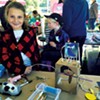Published October 4, 2016 at 10:00 a.m.
It's the first week of kindergarten in Maggie Plante's class at the Integrated Arts Academy at H.O. Wheeler (IAA) in Burlington, and students are enjoying choice time. The kids reflect Burlington's ethnic and cultural diversity and boast a cheerful mishmash of personal styles. There are boys with long hair and girls in sweats and high-tops. Kids wear collared button-downs or glitter T-shirts, gold earrings or retro glasses.
And they play differently, too. A boy building a train track on the carpet notices a classmate standing nearby and invites her to help. A few kids sit at a table, intently coloring cartoon bumblebees. An animated group debates the importance of Pikachu in the Pokémon universe. They find a light-up ball, which they decide is a good tool to catch the digital critter. Then they find green Lego pieces to stand in for e-tablets and pretend to play Pokémon GO.
Plante circulates through the room, offering up plenty of positive reinforcement. "It's so nice to see you sharing," she says. "I like how you fixed how you were sitting in your chair." Academic concepts are introduced with a light touch. A boy squishes Play-Doh through a press and holds it up to show Plante. "Wow. Is that bigger than your hand?" she asks. He compares and gives a tiny, proud nod.
Plante is also making careful observations, squatting down with each group and joining them in their worlds of play. "I have no expectations," she says. "I see how they interact, what language they're using." She notices who always goes straight to the blocks. She notices when kids are using materials in imaginative ways. And she notices "who's a wanderer or a roamer, who hovers but doesn't quite join in."
She'll use the data she's gathering to differentiate her instruction and to fulfill a statewide requirement: Within the first six to 10 weeks of school, the Agency of Education asks that all kindergarten teachers complete an assessment for each of their students. The surveys are analyzed to determine students' skills and — in the broadest strokes — whether or not Vermont's kids are well prepared for school.
Survey Says
In 2000, the state rolled out the kindergarten readiness survey — a collaboration between the Agency of Education, the Department of Health, and the Department for Children and Families. Survey questions have been tweaked over the years, but in 2015-16, the state debuted a new version, called the Ready for Kindergarten! Survey, or R4K!S, which, for the first time, underwent an independent review by the American Institutes for Research. Among the AIR's recommendations was a change in how the state measures survey responses. The R4K!S report, released at the end of September, indicates that 82 percent of Vermont kids are ready for kindergarten, compared to the 49 percent assessed as ready during the 2014-15 school year (see "Behind the Numbers" for an explanation of this dramatic leap).
In the survey, teachers determine whether each student is "beginning," "practicing" or "independently performing" 34 different skills that fit into five categories: physical development and health, social/emotional development, approaches to learning, communication, and cognitive development. The process is strictly observational.
On the front lines, "it's designed to help the teachers, when they first start working with kindergartners, to understand where that student is developmentally, and that helps target what interventions you might provide," explains Deputy Secretary of Education Amy Fowler.
Teachers like Plante, who has taught at IAA for 12 years, refer back to the surveys during the school year in order to tailor instruction to each student. Plante may target skills, like how to share toys, through play, she says. Or she'll group kids of different abilities together so they can learn from each other. A child who is not yet adept at social problem-solving, for example, may be intentionally grouped with a kid who's shown a knack for mediation. Plante says she looks back at the skills she's flagged to make sure each child is making progress.
In smaller Westminster, kindergarten teachers start priming their incoming students for the transition the January before the new school year begins. Teachers do preschool visits, and in the summer they have a two-week transition camp, explained kindergarten teacher Emily Clark. So come survey time, she knows her kids well and has already flagged areas for intervention. She doesn't rely heavily on the survey results to drive her instruction, she says, but finds it helpful in other ways. "It's useful for informing preschools and other early-ed centers what we're looking for," she said.
Prioritizing Preschool
Most kids start kindergarten by age 5 or 6. By then, many of them have already been to preschool. Those pre-K early learning years are crucial in preparing kids to enter school.
That wasn't always clear. It wasn't until the 1990s that the National Association for the Education of Young Children (NAEYC) released a position statement calling it "a public responsibility" to make sure families "have access to the services and support needed to provide the strong relationships and rich experiences that provide children with a foundation for all future learning." At minimum, the statement reads, this requires health care, economic security, nutrition, housing, family support services and "high-quality early childhood programs."
The statement marked a shift in cultural thinking. Researchers at the National Center for Education Statistics say it's having an impact.
A recent NCES study revealed that between 1998 and 2010, poor kindergartners' academic achievement rose, closing the school-readiness gap between rich and poor kids by 10 percent in math and 16 percent in reading. This may be, the study's authors wrote in an August 2016 New York Times article, because preschool is more accessible, poor families are reading to their children more and "because of the widespread diffusion of a single powerful idea: that the first few years of a child's life are the most consequential for cognitive development."
What role does quality preschool play in those early years? Andrea Sambrook, executive director of Annette's Preschool in Hinesburg, points to three key skill groups that early childhood education helps develop. The first is social interactions. Sambrook describes it like this: "Can I successfully make friends? Can I introduce myself to a play scenario and engage in play? Can I engage an adult if I need help or have a question?"
The second, she says, is self-regulation. "That comes into play with waiting my turn, understanding I might not get what I want immediately, delayed gratification, being able to stop myself from acting."
The third group is adaptive skills. "That's a fancy way of saying self-help skills, how a child can do things independently. That's things like changing from outdoor shoes to indoor shoes," she says, or using the bathroom, unzipping a lunch box or putting on a coat. Young children build these skills constantly, she says, "in the block area, when we line up to go outside, when we want to be the line leader but we also want to close the gate, when we want to swing but someone got there first. It's the underlying goal. It never really stops."
Robyn Freedner-Maguire, director of the statewide early childhood campaign Let's Grow Kids, says that since most Vermont parents are working, "the childcare system has a role to play in supporting the public school system, in preparing children so they're ready." Childcare providers are also important economic partners for public schools, she adds, in that quality care can minimize costs. "They're often first to see if children need early interventions," she explains. "You may have children entering kindergarten with social and emotional issues that may require additional staffing in class. There are some challenges children have that could be mitigated if they had access to high-quality early care."
She knows it personally: Her own daughter's childcare quickly recognized that her daughter needed help developing some social and emotional skills, and is working with the family to address them. "The trajectory has changed for her," Freedner-Maguire says, emotion and awe in her voice. When her daughter enters kindergarten, she says, "I can visualize her playing with her classmates. A year ago, I couldn't visualize that."
Supporting Students
Teachers in Vermont's elementary schools prepare for the first day knowing they may be welcoming upwards of 20 kids with varied backgrounds and skill levels. When kindergartners arrive without foundational social skills, it's up to the school to intervene.
"I think the hardest thing teachers do is differentiation," says Bobby Riley, principal of IAA. "You have this wide range of social and academic skills." For example, you may have one student who can't sit in his seat, he explains, and another who's reading on a second-grade level.
IAA has a diverse student population with vastly different needs — and some of those needs are great. "The biggest issue around the achievement gap is students' trauma background prior to starting school," says Riley. Nationally, that gap may be closing, but kids who grow up in poverty, or whose families lived in refugee camps before resettling in Burlington, have a higher degree of trauma or instability in their lives and are less likely to have developed those key social skills. As a result, IAA has focused on trauma training for a few years, and now Burlington is investing in trauma training for its educators district-wide.
Poverty has a profound impact on kids' ability to succeed in school, according to Sue Maguire, retired principal of Molly Stark Elementary School and Mt. Anthony Union High School in Bennington. "It doesn't mean kids can't learn," she explains. "It's not that they might not have the innate ability; it's just that they aren't exposed to the same [resources]. It's not that their parents don't love them; it's just that they don't have the opportunities or the know-how."
There are other traumatic factors, like illness, violence or addiction. In January, Vermont Public Radio reported that Brattleboro's Academy School was seeing an increase in kids arriving unable to focus and function in school, which the school attributed to the state's heroin crisis and more kids experiencing the effects of opiate misuse at home.
And there are other layers of social skills intervention. IAA uses an arts-based curriculum, which embeds skills like cooperation, confidence and determination in arts-based activities, such as performing a play.
The magnet school also uses a violence-prevention curriculum called Second Step that gives kids a common language for conflict resolution and problem-solving. For kids who need the most help, IAA staff form behavior-support teams.
"We think about what supports we can put in place. We write specific behavior plans and social/emotional plans for students," says Riley.
Blue Mountain Union School kindergarten teacher Melanie Gonyaw is in her 21st year teaching and has been at her current school, in Wells River, for close to 15 years. She says different schools have different resources available when a child struggles with behavior in class. "Some schools have behavior interventionists available and ready, and some don't. Not necessarily to remove the child, but so you can continue teaching." Without another adult in the room, teachers have to stop the lesson to redirect the child's behavior, she explains. Sometimes, she adds, assistant principals take on the role of behavior coach.
Like many other schools in Vermont, both IAA and Blue Mountain use Positive Behavioral Intervention and Supports (PBIS), a formal system that helps schools encourage and reinforce healthy behaviors.
Programs like these are critical because, explains Sambrook, "For a child who has not mastered those social skills, they're going to find it extraordinarily hard to focus on the academics. When they're ready, it will come very quickly."
Are Schools Ready?
According to the R4K!S report, the state says "'school readiness' is interactional: Children need to be ready for schools, and schools need to be ready to accommodate the diverse needs of each and every child."
The Vermont Agency of Education used to assess schools for readiness, just as it assesses students. Principals were surveyed on topics including their school's transition-to-kindergarten practices and parental involvement, while teachers answered questions on the amount of support available to them from administrators, behavioral specialists and special educators. But the state stopped gathering that information in 2011; as of press time, the Agency of Education had not responded to requests for an explanation as to why.
Even though that info is no longer formally collected, the question it addressed is still an important one: Are school districts prepared to best serve our newest learners?
Plante says smaller class sizes would help teachers better meet kids' diverse needs. And she thinks a critical part of her job is helping kids learn how to play and use their imaginations. There's an educational catch-22 there: Teachers must help kids develop social skills to be resilient, empathetic people, but mandates strip away opportunities for the natural interactions that build those skills.
"The expectations we have for kindergarten are too big," Plante laments. "Just make it where school is a place they can learn. They come to school and have to work all the time. We've forgotten how to be kind, how to solve a problem."
But that's an issue for another day. For the current crop of kids, school is in session.
Back in Plante's busy kindergarten class, free choice time is coming to an end. To get the kids' attention, Plante sings, "Friends, friends, friends!" The desired response is for all the kindergartners to stop moving, look at her and sing, "Yes, yes, yes!"
They do, and the sound is gorgeous, like bells pealing. "Wow!" says Plante, pleased. Yes, a few kids are still wiggling their hands in the rice table, but they're singing, loud and clear.
Behind the Numbers
In April 2014, Vermont Public Radio aired an alarming story with the headline "Over Half of Vermont's Kids Deemed Not Ready for Kindergarten." The piece cited a Building Bright Futures Report, which included data collected by the Agency of Education during the 2013-14 school year indicating that 51 percent of kindergartners that year were rated by their teachers as not ready for kindergarten.
Last month, the state released the results of the 2015-16 Ready for Kindergarten! Survey, with a striking new finding: 82 percent of Vermont kids are ready. What's behind that dramatic improvement?
Essentially, the state has changed the way kindergarten readiness is evaluated.
Two significant things happened in 2014: The state passed Act 166, which guarantees 10 hours per week of publicly funded pre-K for the state's 3- to 5-year-olds; and the state won a $33 million federal grant to expand preschool programs to low-income kids. This prompted the Agency of Education to have its kindergarten readiness survey independently reviewed by the American Institutes for Research.
"Given the opportunity to improve an instrument, this was the time to do it," says Deputy Secretary of Education Amy Fowler. "A big reason for making the change at this time is, it's baseline data for moving forward," she says.
AIR reviewers recommended a few changes in the survey, including the way results are evaluated. In past years, a kindergartner had to be proficient in every single skill in the survey to be considered "ready" overall. With the new system, a child can demonstrate a "beginning" skill in a category and still be considered "ready" overall by the state. A child is scored on a scale of one to three on each of 32 survey items (there are 34 survey items, but two descriptive questions aren't included in the tally). The child's total score lands him or her in one of four readiness categories: "not yet ready," "approaching ready," "ready and practicing," and "ready and performing independently." Like academic proficiency tests for older school-age children, children whose scores fall in the top two categories are considered "ready" overall.
In other words, kindergartners haven't changed. The new evaluation criteria just gives them a little more readiness wiggle room. Fowler offers an analogy: "When you go to take your driver's test, you're allowed to miss a couple of questions and still get your license."
The report breaks down differences by gender, school district, free/reduced lunch eligibility, and whether or not kids attended publicly funded pre-K (though the 2015-16 report lumps together kids who attended non-publicly funded pre-K and kids who attended no pre-K whatsoever).
The state hopes more accurate survey data will help school systems and pre-kindergarten programs collaborate better. For example, if a district notices a year-after-year drop in certain skills, Fowler explains, they can work with pre-K providers to intervene.
Even with the changing criteria, Fowler emphasizes that around 20 percent of kids last year were assessed as not ready for kindergarten. "There's still some room for growth, and that's what we're hoping pre-K will do," she says. "The push for pre-K is not just to provide students access for learning how to be in a community before school starts, but to give those students a leg up so they can progress even further."
To view the full Ready for Kindergarten! Survey report, visit education.vermont.gov.
This article was originally published in Seven Days' monthly parenting magazine, Kids VT.
More By This Author
Speaking of...
-

Vermont Senate Votes Down Ed Secretary Nominee Zoie Saunders
Apr 30, 2024 -

Governor Makes Last-Minute Appeal to Delay Vote on Ed Secretary Nominee
Apr 29, 2024 -

Senate Committee Votes 3-2 to Recommend Saunders as Education Secretary
Apr 24, 2024 -

Court Rejects Roxbury's Request to Block School Budget Vote
Apr 24, 2024 -

Ed Secretary Saunders Fields Questions at Confirmation Hearing
Apr 23, 2024 - More »
Comments
Showing 1-1 of 1
Comments are closed.
From 2014-2020, Seven Days allowed readers to comment on all stories posted on our website. While we've appreciated the suggestions and insights, right now Seven Days is prioritizing our core mission — producing high-quality, responsible local journalism — over moderating online debates between readers.
To criticize, correct or praise our reporting, please send us a letter to the editor or send us a tip. We’ll check it out and report the results.
Online comments may return when we have better tech tools for managing them. Thanks for reading.

















































